





 |
 |
 |
 |
 |
 |
| Andrys Basten | profile | all galleries >> TURKEY Photos - Anatolia, 2004, with Canon Elph >> Photos: Mt Nemrut heads, Perre-Perin, and Diyarbakir | tree view | thumbnails | slideshow |
|
Pirin Caves - Perre excavation area, cave tombs, Adiyaman area . . . Mt Nemrut's gigantic heads (Antioch's especially, for placing himself with the gods), which once were part of the sitting figures in the back. The chairs and torsos; and tumulus on top of the mountain are considered quite an engineering feat. Diyarbakir, rich in (military) history, is primarily Kurdish. The Blue Guide: Turkey says, "Perhaps the best time of the year to visit Nemrut Dagi is early October, as then the loneliness and isolation of this bizarre funerary monument are very apparent. There are few visitors and the first flakes of snow on the summit herald blizzards that will soon isolate the mountain sanctuary completely. Abandoned by man, only the wild animals and birds that shelter among its ruined stones keep company with the spirit of Antiochus during the long, dark months of winter."We were there October 6. It definitely was very windy, and also slippery on the stone pebbles. |
 Adiyaman Museum - little Nemrut tumulus and heads display I had been under the impression that these were found in an
|
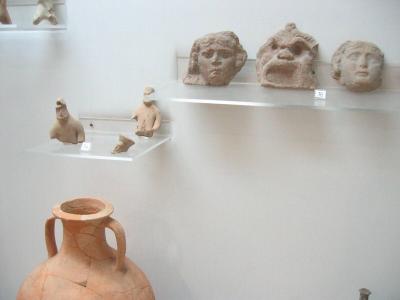 A Roman era display I especially liked. Very human expressions, 3rd BC, on the faces around the odder face-mask.
|
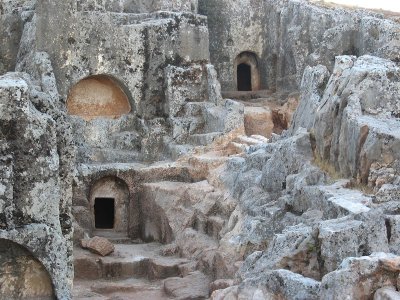 Perre excavation area - Pirin Caves The sun was setting, but we were told, at Adiyaman Museum,
|
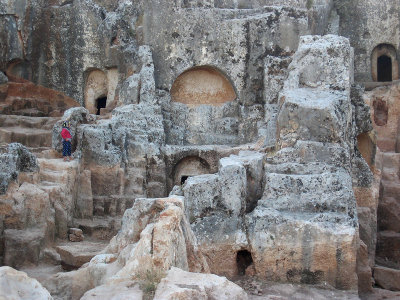 Visitor surveying scene |
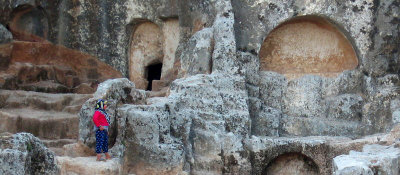 Colorfully-dressed visitor to the Pirin cave tombs |
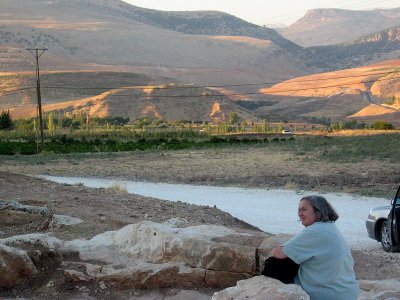 Across from the newer Perre excavation areas at Pirin Caves |
 Same excavation area |
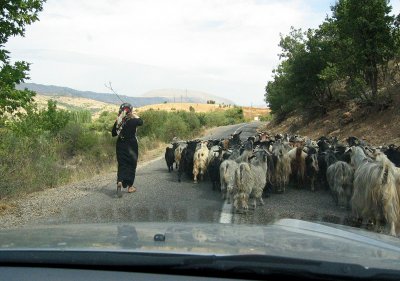 Road on the way up to Mt. Nemrut area Cracking the branch with those goats |
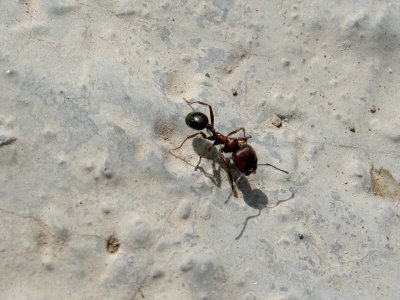 Giant ant at the cafe area below Mt. Nemrut's tumulus |
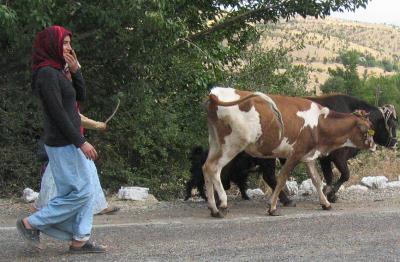 Scene on our way to tackle the bumpy basalt-rock road to Mt. Nemrut |
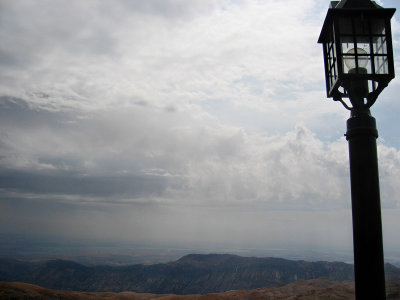 Entrance area of Mt. Nemrut |
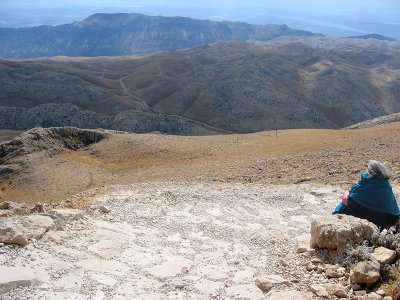 Resting on the way up to the large tumulus Antiochos I built to commemorate himself. |
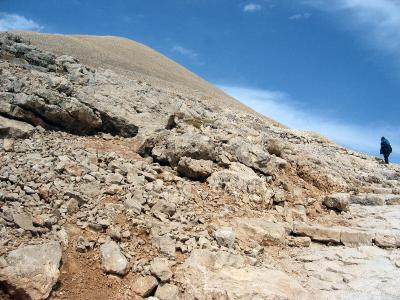 Antiochos I's tomb may be somewhere inside that mound 7,000 ft high |
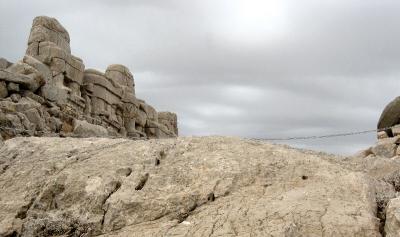 Approaching the foot of the tumulus: first sight of the headless-god chairs Never 'discovered' the West side, alas.
|
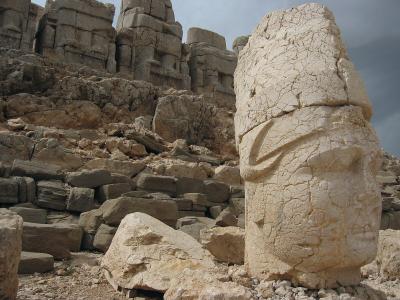 Apollo? For a good aerial perspective of where we were and the road to that spot,
|
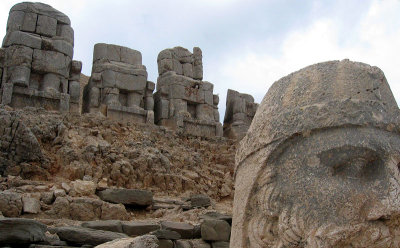 Zeus. The heads, toppled, were missing sections. Don't miss this historical mpeg video on the discovery of the site. |
 Zeus. Chairs and torsos behind, above. Earthquakes caused toppling of heads. The holes in the tops of the heads (more visible in other pictures) indicated these were used with
|
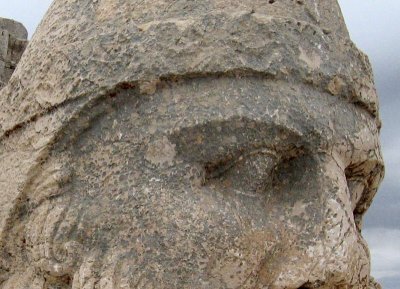 The heads were built separately and placed on the torsos. Reminded me a bit of a weathered Rodin's The Thinker. Here's another one
|
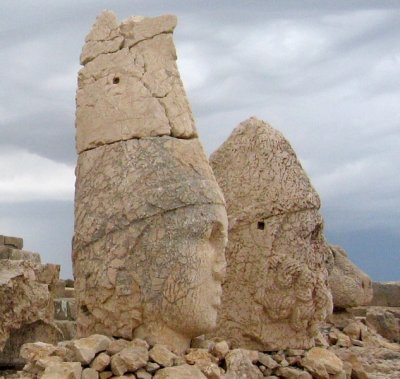 Antiochos I, who placed himself among the gods. Several websites, even within their own sites, disagree on which is meant to be Apollo
|
 Zeus, Antiochos I, Heracles Here is a website with 3-D video (also seen as text info),
|
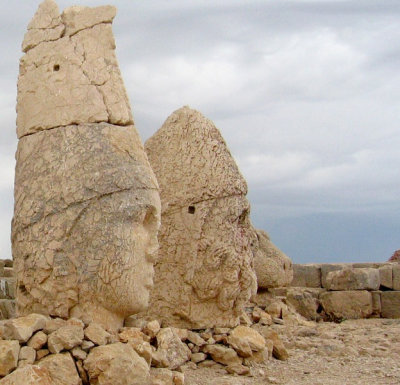 Antiochos I and Heracles again Antiochos I claimed that his mother (Laodike) was a descendent of Alexander the Great and that his
|
 Guardian lion facing statutes ... with no teeth or claws (that I can see) but I'd still beware ! :-)
|
 What the chairs face |
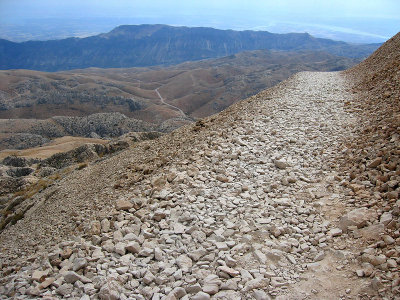 Level portion high up above hills below |
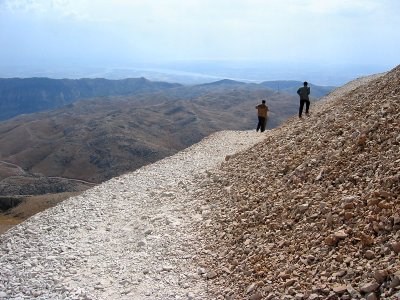 Steep drop from highest mountain in Northern Mesopotamia, it's said |
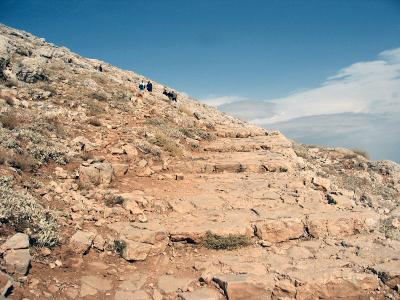 Steps with less rock piles than many we encountered On the ones with large rocks, with loose pebbles on them, I was too busy trying to balance, to
|
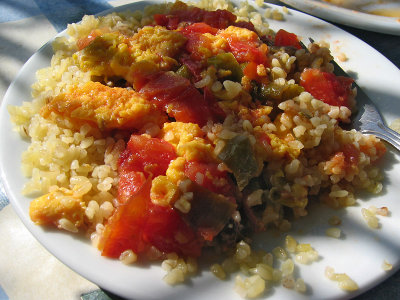 Our first menamen! or menemen! (Turkish omelette) at cafe nearby. The cafe was below the entrance at the top. We rode a very rocky road
|
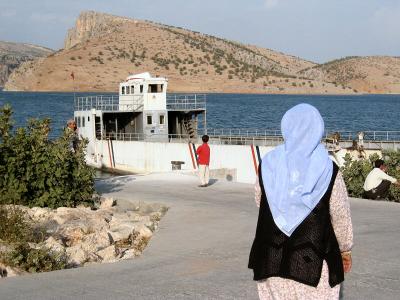 We put the car on a Lake Van ferry after Mt Nemrut climb. |
 We were on our way to the walled city of Diyarbakir. This was after the Menamen omelette, our reward for doing Mt. Nemrut.
|
![No elevators, and the height of each stair is rather high
(not apparent here), a bit arduous following Mt. Nemrut that day [whine] :-)
We had empathy for the hotel guys bringing up our very heavy suitcases.](https://a4.pbase.com/g6/97/295097/3/36316601.xEv5fh5u.jpg) Stairs at our restored caravan-stop (Deliler Han), now Hotel Kervansaray. No elevators, and the height of each stair is rather high
|
 The courtyard, from the 2nd floor where we were staying. In the 1500s this was a popular stop for the traders and camels.
|
 Watermelons are big in Diyarbakir That's literally (in some cases, 100 lbs ) and figuratively.
|
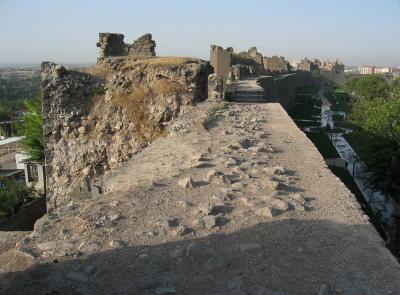 Lil' ole ladies on top of impressive walls of Diyarbakir The black basalt walls of this ancient city are the 2nd largest and best
|
 Resting again :-) at the top of a Diyarbakir wall (longest of ancient Anatolia). The walls surround the city and are about 5.5 kilometers (or 3.4 miles) long. |
| comment | share |
| Guest | 29-Dec-2005 17:48 | |
| Guest | 06-Nov-2005 23:00 | |
| Steve Goldthorp | 06-Dec-2004 22:04 | |
| Andrys Basten | 15-Nov-2004 05:39 | |
| Ruth | 14-Nov-2004 20:15 | |